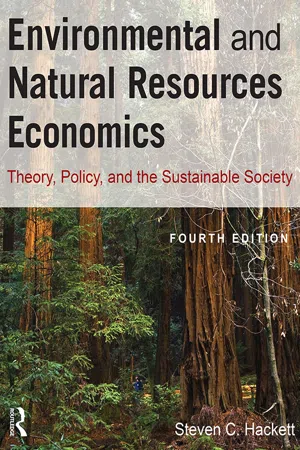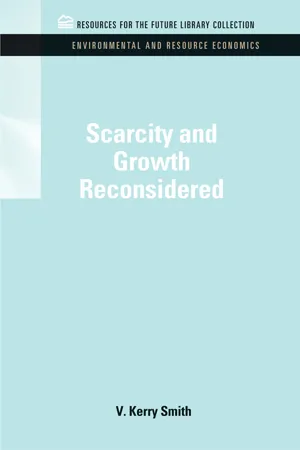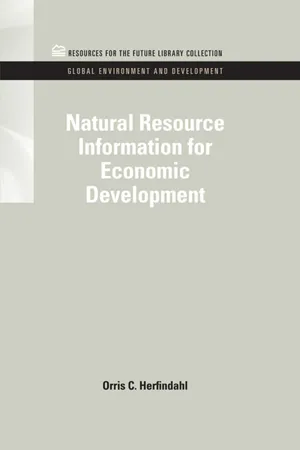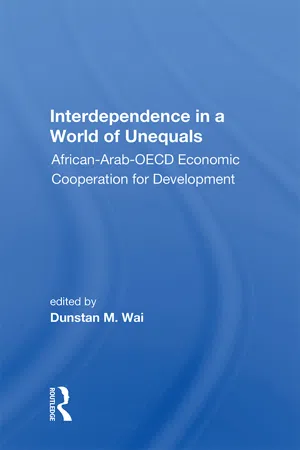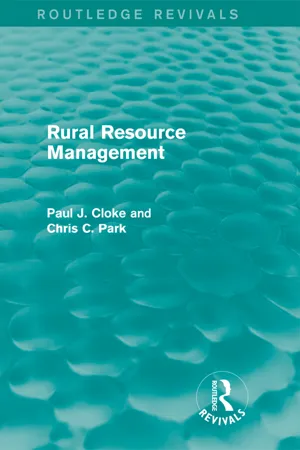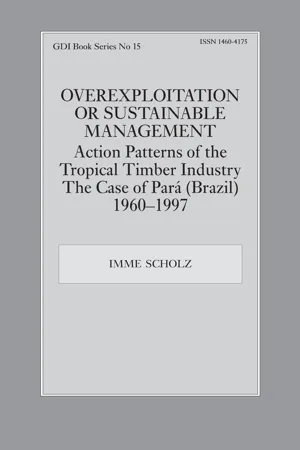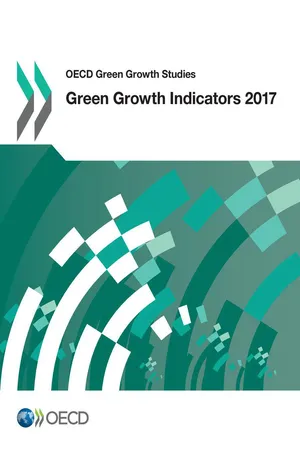Economics
Natural Resources
Natural resources are materials or substances that occur in nature and can be used for economic gain. They are often classified as renewable or non-renewable and include resources such as water, air, minerals, forests, and wildlife. These resources are essential for the production of goods and services and play a crucial role in the functioning of economies.
Written by Perlego with AI-assistance
Related key terms
8 Key excerpts on "Natural Resources"
- eBook - ePub
Environmental and Natural Resources Economics
Theory, Policy, and the Sustainable Society
- Steven Hackett, Sahan T. M. Dissanayake(Authors)
- 2014(Publication Date)
- Routledge(Publisher)
Chapter 5 Natural Resources Economics Part I: Theory and Concepts
DOI: 10.4324/9781315704586-5Introduction and Overview
Environmental economics is primarily concerned with identifying externalities and evaluating regulatory policies designed to control them. Traditionally, Natural Resources economics has been concerned with the optimal use and management of natural resource systems. An element of nature is a natural resource when it is directly useful to people, or when human technology can utilize it to form something valuable. For example, petroleum bubbling up through the ground and fouling soil was considered a nuisance to farmers in the nineteenth century until the development of refining and internal combustion engine technology transformed this material into a valuable natural resource. More recently, porous underground rock formations near coal-fired power plants have become valuable resources for carbon capture and sequestration, and new systems of property law are being developed to determine ownership and use of this resource.Natural Resources Economics Field of study that focuses on the supply, demand, management, and allocation of Earth’s Natural Resources.As will be shown in this chapter, the price of a natural resource reflects the relative scarcity of the resource and the availability of substitutes, and it acts as a driver for technological innovation. Increasing scarcity will tend to increase the resource’s price, reduce quantity demanded, and promote the production and consumption of substitutes.The dramatic peak in petroleum prices in the summer of 2008 offers an interesting illustration of how firms and households respond to a volatile energy resource market. Between January 2007 and July 2008, the average price of gasoline in the United States rose by nearly 80 percent. Smith (2009) - eBook - ePub
- V. Kerry Smith(Author)
- 2013(Publication Date)
- RFF Press(Publisher)
3 of some natural resource, there is, at most, a very long-run problem.2. It must be nonrenewable and nonrecyclable. Natural Resources (such as metals) do not disappear after they are used; rather, they become available for reuse. Only that part which is not renewable—or more precisely, that part, for which the cost of renewing to a marketable state will exceed the market prices—is exhausted in economic terms. The net utilization rate of Natural Resources may thus be considerably less than the gross.3. It must be essential, that is, it must be required for production (or consumption). 4. There cannot exist substitutes for it; for example, capital cannot be substituted for it in production.5. It must be impossible to improve the efficiency with which the resource is utilized beyond some point; for there to be an immediate problem, we must be near that point. Technical change which increases the productivity of a resource is referred to as "resource-augmenting technical progress," since its effect is equivalent to an increase in the stock of the resource.6. It must be impossible to develop a substitute for the given resource.Several of the recent articles on the economics of Natural Resources have attempted to make more precise the conditions under which it is possible to sustain a constant per capita consumption [2-4], Most of these conditions are fairly intuitive.The assumption that the natural resource is essential implies that the isoquants (between the natural resource and the other produced factors of production) never hit the axis of the produced factor. (See figures 2-1 to 2-7 where the other factor of production is taken to be capital. In figure 2-1 Natural Resources are essential; in figure 2-2 Natural Resources are not essential.) Note that what is crucial for the question of whether the natural resource is essential is not any property of the production (isoquant) function when there is a large input of Natural Resources. If the isoquant has relatively little curvature (i.e., is flat, as in figure 2-3 ) we might be tempted to extrapolate the curve and to infer that the natural resource is nonessential, but the curvature could easily be changed as the resource input becomes small, so that although at present it is easy to substitute, say capital, for resources, eventually it becomes quite difficult. Conversely, it may be quite difficult to substitute now (the isoquant can still be quite curved) but when the resources become sufficiently scarce, we may be able to switch to a completely different technology, for which the substitution is relatively easy, and the isoquant does hit the axis (figure 2-4 - eBook - ePub
Economic Growth
International Edition
- David N. Weil(Author)
- 2016(Publication Date)
- Routledge(Publisher)
The roles of resource prices and property rights are particularly relevant when we examine how economic growth affects the environment. The key difference between a clean environment and other Natural Resources is that most of the time, no one owns a clean environment, so no market price is attached to creating pollution. For this reason, environmental degradation—particularly for the aspects of the environment that are least subject to property rights, such as the atmosphere—is more likely to be a problem associated with economic growth than is a shortage of Natural Resources.
We begin by examining the different forms of Natural Resources, their measurement, and their use in economic activity.NATURAL RESOURCE CONCEPTS16.1Nonrenewable Resources
A nonrenewable resource is one that exists in a fixed quantity on the earth. When a nonrenewable resource is consumed, it is gone forever. A common measure of the availability of a nonrenewable resource is the level of current reserves, or the known quantity of the resource that can profitably be extracted at current prices using existing technology. Changes in the quantity of current reserves are brought about through four processes. The first two of these are the obvious ones: discoveries of new stocks of the resource raise reserves and depletion of existing stocks lowers reserves. The third way in which reserves can change is when the price of the resource changes: for example, if the price rises, then known deposits that were previously not worth extracting can become economically viable, increasing reserves. Finally, changes in technology can also make it worthwhile to extract a resource from a known deposit, even if the resource’s price has not changed. In recent years, an important example of this effect has been the development of hydraulic fracturing (“fracking”), a technique that allows for the recovery of natural gas and oil from deep shale formations.To look in more detail at data for a nonrenewable resource, we examine the most important one in the world today: oil. In 2011, oil accounted for 33% world energy production, followed by coal (28%), natural gas (22%), renewables (11%), and nuclear (5%).1 - Raymond F. Mikesell(Author)
- 2013(Publication Date)
- RFF Press(Publisher)
I: The Role of Natural Resources in Economic Development In order to clarify the purpose of gathering information about Natural Resources, it is necessary to be clear about their economic significance. Failure to follow the dictates of common sense in thinking about the economic significance of Natural Resources may result in considerable mismanagement. The purpose here is not to put forward a theory of economic development or even to indicate adherence to one of the many current versions. Instead, the much more limited goal is to point out some aspects of the exploitation of Natural Resources that are important and with which any useful view of the process of economic growth ought to be consistent. Natural Resources as a Capital Stock To start with, no particular type of natural resource is essential to a high level of national income or to economic progress. We can assert with confidence that a country’s endowment of Natural Resources need not exercise a determining influence on the course of its national income over time—if it is able to trade. “All” that is necessary for economic progress is the availability of a substantial quantity of services of capital and labor—with a considerable part of the capital embodied in persons—plus a social system with certain characteristics favorable to systematic improvement of production practices. And the more capital per person the better. The truth of this observation is evident from the economic success of countries with limited Natural Resources and the success of countries with greatly different natural endowments. To enjoy economic success, a country must have access to Natural Resources, but this can be had through trade with other nations with a different or better natural endowment- eBook - ePub
Interdependence in a World of Unequals
African-arab-oecd Economic Cooperation For Development
- Dunstan M. Wai(Author)
- 2019(Publication Date)
- Routledge(Publisher)
Part 2 Natural Resources, Oil Bills, and Patterns of TradePassage contains an image
4 Resources, Scarcity, and Development Priorities in Sub-Saharan Africa
Suleiman I. KiggunduA full picture of the resource base of sub-Saharan Africa would ideally require us to make an inventory of all natural and manmade resources. Natural Resources would refer to "a concentration of naturally occurring solid, liquid, or gaseous material on the earth's crust."1 If these command a positive price we refer to them as economic resources. But if they occur in abundance, like common water and air, and have a zero price, then they are grouped among the noneconomic resources. Generally, economic Natural Resources would include all land, forests, fisheries, animals, labor, water, and mineral resources. On the other hand, manmade resources are production inputs like capital equipment and raw materials, manmade forests and waters, labor skills, technology, and land improvements.This second category of manmade resources is particularly difficult to inventory. Thus it is difficult to define the resource potential of any area of the world because technology and research and development can work miracles on Natural Resources. To avoid these problems this chapter will concentrate on analyzing the natural resource base of sub-Saharan Africa with only a few remarks suggesting the potential for its improvement. Within the limits of available data, the extent to which these Natural Resources have been exploited will be presented. Lack of manmade resources will be found in many cases to be the crucial bottleneck in the full utilization of Natural Resources. It would be useful to identify which of these resources constitute "economic reserves," that portion of the resource that can be economically and legally utilized under present economic, technological, and legal circumstances. The determination of reserves would require extensive studies on a national and a continental scale. Such studies should ideally follow a rough mapping of the type undertaken in this study and should be done on a country, sectoral, industrial, and project basis. Indeed, this will be the next phase when it comes to tightening African-Arab-OECD cooperation, when the partners in the game choose to act for economic or noneconomic imperatives. - eBook - ePub
- Paul Cloke, Chris C. Park(Authors)
- 2013(Publication Date)
- Routledge(Publisher)
The significance of non-utilitarian resources depends largely on the extent to which a given society regards these either as luxuries or necessities. For example, a population with a relatively high standard of living can readily devote greater consideration to the need for clean supplies of air and water, and access to unspoiled recreation areas and open countryside, than a population with food shortages, widespread unemployment and generally lower material standards of living. 18 TABLE 2.2 Classification of Natural Resources 17 NON-RENEWABLE RESOURCES ‘are not generated or reformed in nature at rates equivalent to the rate at which we use them’, eg. petroleum. RECYCLABLE RESOURCES ‘resources…which are not lost or worn out by the way we use them, and can be reprocessed and used again and again’, eg. many metals. RENEWABLE RESOURCES ‘include all living things that have the capacity for reproduction and growth. As long as the rate of use is less than their rate of regeneration, and as long as their environments are kept suitable, they will go on replacing themselves. However, living communities are not necessarily renewable, if the way in which we use them is destructive. No living species can survive if we crop it at a rate more rapid than it can reproduce, or if we destroy the habitat in which it depends’. INEXHAUSTIBLE RESOURCES ‘those such as sunlight, which will continue to pour onto the earth as long as humanity will be around, whether we use it in certain ways or not’ - eBook - ePub
Overexploitation or Sustainable Management? Action Patterns of the Tropical Timber Industry
The Case of Para (Brazil) 1960-1997
- Imme Scholz(Author)
- 2018(Publication Date)
- Routledge(Publisher)
From the viewpoint of ecological economics the subdivision of the discipline into environmental and natural-resource economics along the lines of static and dynamic considerations is unsuitable: the external effects that accrue when the environment is exploited also have a dynamic component in that any calculation of the costs and benefits of avoiding or eliminating them would have to take account of the assimilation capacity of natural ecosystems with an eye to stability aspects. For this reason Odum (1980) broadens the concept of Natural Resources to include all natural life-support systems. As a multifunctional storehouse of natural capital, the natural environment provides flows of multipurpose services that are essential for human life and hence at the same time for economic activities (welfare). The essential services are:- – Supply of the Natural Resources used as energy and material inputs in the economic process;
- – assimilation and degradation of waste products from the economic process of production and consumption;
- – provision of a flow of environmental services for individuals and production systems (here it is not a matter of directly physical exchange processes but of the maintenance of stable ecosystems and the general environmental quality needed for life).
From an economic viewpoint a problem of relative scarcity arises when, in utilizing the environment, one of these three functions is over-stressed at the expense of the others. This is true above all of the third function, since the physical dependence of economic activities does not enter into market-mediated processes.Technological progress can alleviate this relative scarcity to the extent that it is possible to lower consumption by raising efficiency.„Resource-dependent economic growth will tend to bias natural-resource allocation towards meeting the physical needs of the expanding economic process –in terms of the provision of raw materials and the assimilation of waste. This would be to the detriment of the provision of environmental services, unless economic policy explicitly corrects this allocation processby taking into account the growing relative scarcity of these natural services. " (Barbier 1989, p. 97)A problem of absolute scarcity - eBook - ePub
- OECD(Author)
- 2017(Publication Date)
- OECD(Publisher)
Part 2. The natural asset baseLand resources Forest resources Freshwater resources Biodiversity, ecosystems and wildlife resourcesPassage contains an image
Land resources
Land and soil resources are essential components of the natural asset base of the economy and of ecosystems. They are both a private property and a (global and local) common; they are critical for the production of food and other biomass, support recreational activities and, more generally, provide a physical foundation for all economic activity. The way land is used and managed influences everything in the environment. This ranges from biodiversity and ecosystem services (including erosion risk, flood protection, etc.) to soil, water and air quality, and greenhouse gas (GHG) emissions.The market value of land varies by location. Where demand is low, land is relatively abundant. Elsewhere, many competing demands on land lead to its relative scarcity and drive up its price. Unregulated development driven by the desire to maximise market value leads to conversion of land to the highest-value use. This process, however, fails to account for the ecological value of land. For instance, urban settlements historically developed along navigable streams, sacrificing riparian and wetland ecosystems. Nowadays, in many developed countries, urban expansion mainly occurs at the expense of farmland. Exploitation of Natural Resources (unsustainable logging, mineral extraction), construction of transport infrastructure, and agricultural expansion continue to be the main drivers of deforestation worldwide.These underlying drivers and the resulting land cover change are leading contributors to the loss of biodiversity and ecosystem services globally (CBD, 2010). Land development and the resulting changes in land cover lead to habitat fragmentation and loss. They are thus associated with a decline in the populations of many species and reduced biodiversity (Karousakis, 2012). Conversions of agricultural land to artificial land (which include at least partial soil sealing) irreversibly degrade soil and lead to the cumulative loss of productive agricultural land.
Index pages curate the most relevant extracts from our library of academic textbooks. They’ve been created using an in-house natural language model (NLM), each adding context and meaning to key research topics.
